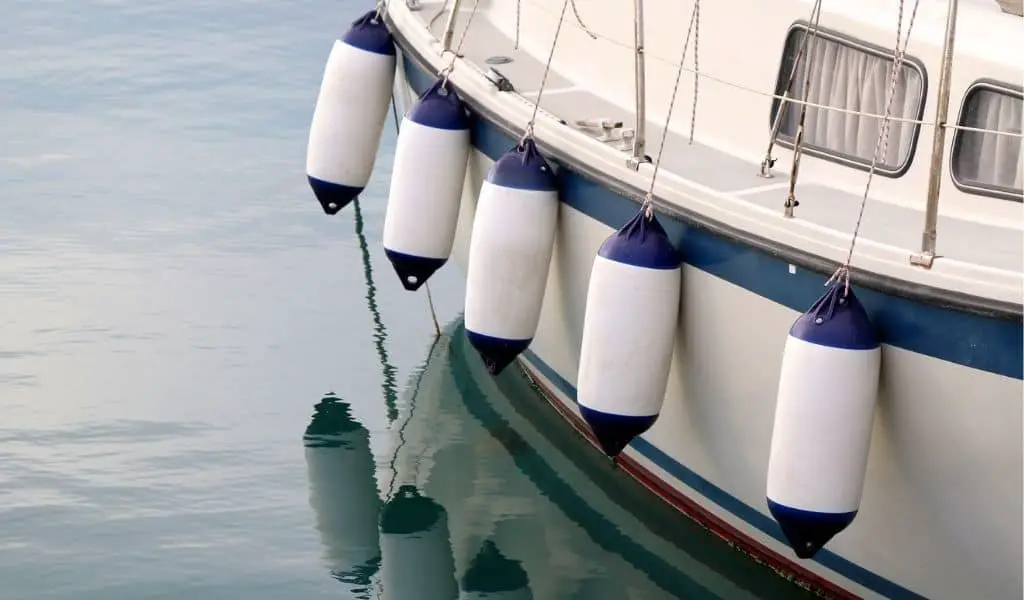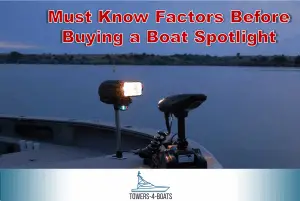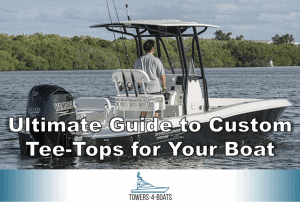Most any boater knows that they need to protect their investment when it’s docked so that vitals like the hull aren’t damaged by moorings, pilings, and other boats. This is especially true for rougher water conditions.
Where boating novices often go astray is in properly identifying the equipment they need to do the job.
What Exactly Is A Boat Fender?
A boat fender is a buffer zone between your boat and other objects while your boat is docked, rafted, or anchored. It absorbs the shock from an object that would’ve otherwise come into contact with your boat and possibly damaged it. And, it decelerates your boat in docked rolls and surges.
Historically, fenders were hand-woven of rope in various different patterns. It’s an all but dead practice today, however, unless you’re trying to keep to the aesthetic authenticity of an antique vessel. Rope fenders simply aren’t able to absorb the kinetic energy that rubber, foam elastomer, and plastic fenders can absorb.
Modern boat fender designs are typically either made of soft form or an inflatable model. The latter should be inflated to feel similar to a basketball or football. Most models can be inflated using any standard needle air pump.
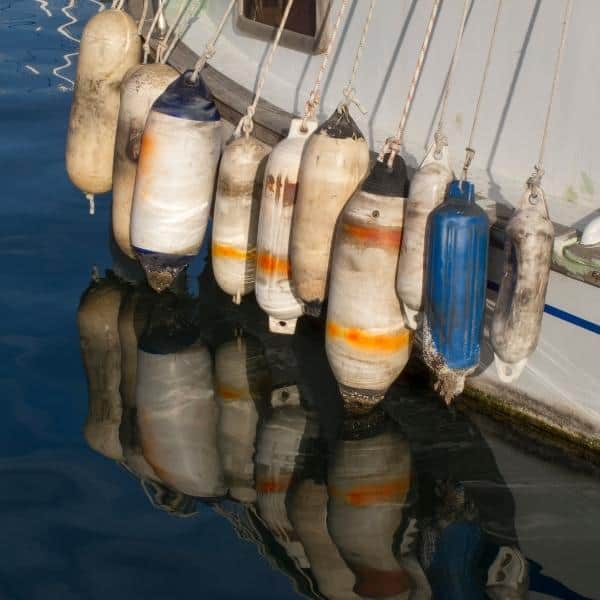
Of course, you can purchase fenders as plain-Jane stock or specialize it to your boat with custom painting and embroidery. There are also a number of accessories to make storage, cleaning, and operation easier.
Check out this Best Value – Boat Fender
Boat Fender vs Bumper: What’s The Difference?
Just like a vehicle’s bumper and fender are two separate entities, boating fenders and boating bumpers aren’t synonymous with each other either.
While boating fenders and bumpers accomplish similar protective outcomes, they are two different pieces of equipment. A boating bumper attaches to the dock as a bumping protection, whereas a fender attaches to your boat to fend off objects coming into contact with it.
Now, you can ensure that you ask for the right equipment and don’t get any snickers from your more seasoned boating enthusiasts.
Types Of Fenders For Your Watercraft
Because there are so many types, sizes, and shapes when it comes to watercraft, you have an equal array of fender sizes and shapes to choose from. This is really just a style preference with some consideration on whether you want a hang that’s vertical, horizontal, or the ability to choose either. Let’s look at some of your fender style options:
• Cylindrical Fender
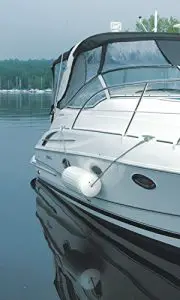
These are the most commonly seen boat fenders to ensure berthing for shorter, lighter boats is safe from damage at dock. They can be hung horizontally, vertically, or both depending on the design.
Center rope designs, such as Big B’s, have a threaded rope through a hole in the fender’s centerline; it can be hung horizontally or vertically. Figure-eight knots prevent slippage.
Fenders with an eye on one end are threaded with rope secured by the bowline to only hang vertically.
Those with an eye on both ends of the fender can utilize one eye to hang vertically, or they can make use of both eyes to hang horizontally with a half-hitch or figure-eight stopper knot.
Arch fenders are a similar type of fender utilized by small to mid-sized vessels. The arched-design just helps to more evenly dissipate the stress of an object coming into contact with your boat.
• Round Fender
Round fenders are typically soft vinyl designs. They’re most commonly employed as low-tech mooring buoys and raft-ups and by larger powerboats with flared bows and commercial fishing boats. They work great when the vessel’s structure presents a significant distance from the dock.
• Flat Fender
These are generally non-inflatable foam designs that are modular or articulating and vinyl-covered. They’re ideal for smaller boats, especially those with tumblehome topsides that inwardly slant at the gunwale. Flat fenders are typically secured to life lines or gunwales. Modular flat fenders can be strung together for a customizable fit.
Extreme Max 3006.7246 BoatTector 26″ Flat Fender Value Pack, Black
• Transom Mounted Fender
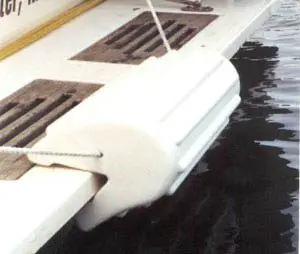
These are great for Mediterranean-style docking, whereby you dock stern-to-marina. The mounted fenders protect transom, swim steps, and so forth.
• Low Freeboard Fender
The smaller-sized low freeboard fenders are ideal to protect vessels that sit low in the water, including ski boats, fishing boats, and bass boats. Larger versions help prevent boats from ridding up under higher docks during rising tides.
Taylor Made Products Low Freeboard Boat Fender (5″ x 14″, White)
• V-Shaped Freedom Fender
These handy fenders are utilized by captains of everything from yachts to small fishing boats. They feature a nifty self-centering shape that removes a piling’s ability to move your fenders out of the way.
• Tuff End Fender
Mostly popular with commercial captains and larger boats, the large, heavy-duty, and rugged tuff end fenders are great protection for deep, flared hulls.
Taylor Made Products 1149 Tuff End Inflatable Vinyl Boat Buoy, White, 18 inch Diameter
• Pontoon Fender
Pontoon boats typically feature some rather unusual corners and more delicate aluminum fencing. Fender applications like the Pontoon Protector 90 and Pontoon Curve Protector are two excellent examples of fenders specifically designed with a pontoon’s components in mind.
• Rafting Cushions
These versatile applications are commonly used as both a fender and bumper. Their large surface area, stay-put design, and multiple options for mounting make them ideal for tying to pilings as a bumper and as a fender in rafting boats together.
• Square Makeshift Fenders
Type 4 PFDs are square throwable floatation devices, but they’re also good as seat cushions and fender alternatives if you’re in a bind.
Size Matters When It Comes To Fender Selection
Fenders can’t do their job if they’re not deployed properly and in the right sizes and numbers. After all, it’s only the width and placement of the fender that separates your boat from objects that could scratch, dent, or impale it.
A common novice boating mistake is in selecting a slew of small fenders in trying to figure out what type is best for your boat. While micro details are in the design, it’s appropriate size and number selection that offers you the real protection here because these are what impact how much of the shock is absorbed when your vessel comes into contact with another object.
The two most important takeaways for fender size and number selections:
- Inflatable cylindrical fenders should ideally be at least an inch thick in diameter per every five feet of the boat’s length. Up that to two inches of thickness for round and hybrid-round fenders. As a general rule: 20-foot and under equals small fenders, 20-foot to 35-foot equals medium fenders, and those over 35-foot need large fenders
- As a general rule, use a minimum of three fenders, and ensure there’s at least one fender per 10 feet of waterline. So, boats under 40-foot can use three fenders, boats around the 40-foot range should have at least four fenders, and boats around the 60-foot range should have at least six.
Keep in mind that the above isn’t a one-size-fits-all recommendation. You’ll need to consider boat weight, environmental conditions, risk, location and so forth in your assessment.
It’s a given, for example, that if your boat is in a high-risk, unprotected, or nasty chop area verses a calm lake dock, then you’ll need to amp up your protection game in numbers and size when you’re selecting your fenders.
How Do You Hang Your Fenders?
Hanging your fenders at the correct height and with the proper suspension is just as vital as size and number.
In tying to floating docks, most boaters set fenders just above the waterline. In using a fender to raft together with another boat, it’s best to set the fenders wherever the beam is widest at the point of contact.
Pilings at your dock present a special challenge for fenders because they tend to push them aside, which then enables contact with your boat. Most boaters use a fender board that spans the distance between pilings to avoid this issue. The vessel can then ride against the wharf relatively secure against damage.
Properly Docking And Rafting With Fenders
Fenders can get snagged on other boats, piling, and other obstacles, which can cause a number of damages and even cause the steerer to lose control of the boat. So, whether you’re docking or rafting, it’s crucial to put your fenders out at the appropriate times.
You never want to secure fenders before docking. If you have a crew, they should hold the fender line so that they can time placement accordingly. Use a slip hitch or clove hitch for easy movements. Once you’ve completed the rafting or docking, then secure the fenders.
Remember to secure the fenders nearest the widest beam point and at the lowest attaching point. If a lower spot, such as a cleat, isn’t available, then lifelines can be used.
You can use the following tips to help ensure you have good fender usage:
- When you use a particular fender for the first time, stick around after docking to ensure they’re performing properly and in good placement.
- If docking for an extended period of time, ensure fenders and lines have a solid water clearance so that they don’t grow algae and barnacles.
- If docking next to piling, use a horizontal hang to help prevent rolling, or you just use a fender board with two cylindrical fenders.
- Remember to use figure-eight or half hitch knots to prevent slippage with center rope cylindrical fenders hung horizontally.
- Remember to check the tidal range so that your fenders don’t fall underneath dock.
- Remember that fenders are for both sides of your docked boat, one to protect against damage from the dock and the other to protect against damage from drifting, rafted, crowded anchorages, and so forth between your boat and others.
- When rafting sailboats together, check spreaders to ensure they won’t hit during rolls. You can move spreaders behind or ahead of each other with a spring line.
While it might give your fellow boating enthusiasts a good chuckle, our last tip to you on boat fenders is a reminder to not take off from dock until you’ve removed and stored your fenders. You can spot a newbie a mile away by the fenders left hanging over the side as a boat motors away to open water. ‘Fend’ your reputation by just not being that guy or gal.

